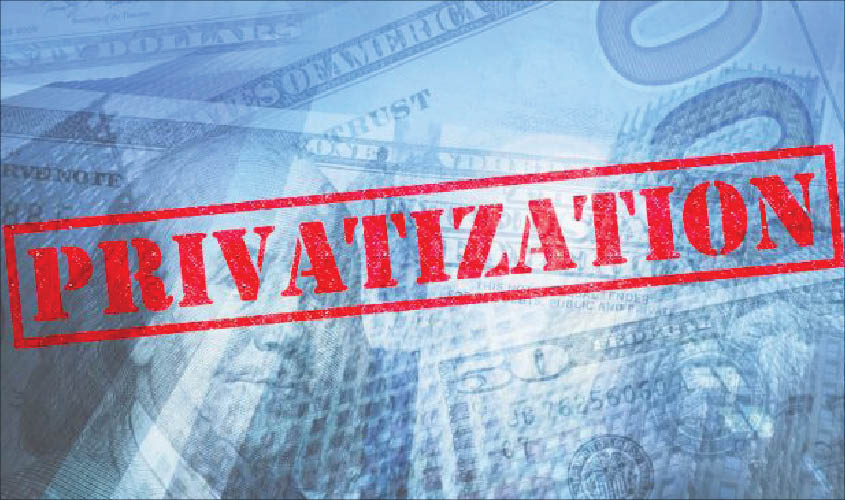If the government stays the course, it will not only be able to address the issue of resource crunch but also lower taxes, and boost growth and employment.
The government’s push to privatisation will be a big boost to the economy, provided it stays the course. Intent seems to be there, but the same cannot be said about courage, as we shall see. Still, the announcement that the 28 public sector undertakings or enterprises (PSUs or PSEs) are on the block is welcome.
“The government has given in-principle approval for strategic disinvestment of (sic) 28 CPSEs [Central PSEs] including subsidiaries, units and joint ventures with sale of majority stake of Government of India and transfer of management control,” Minister of State for Finance Anurag Thakur recently informed the Rajya Sabha.
What is significant is that the PSUs to be sold are not just loss-making ones like Air India and its subsidiaries, but also profitable companies like Dredging Corporation of India, Rural Electrification Corporation Limited (REC), and Hindustan Petroleum Corporation Limited (HPCL).
So far, so good. But what, pray, is the Narendra Modi government’s policy on PSUs and disinvestment? Well, to begin with, there is no longer a department of disinvestment; as per the ruling dispensation’s penchant for inspirational acronyms, it has been replaced with the Department of Investment & Public Asset Management or Dipam.
Since the Congress-led United Progressive Alliance government was dependent upon the support from the Left (from outside) for four years (2004-08), the commies torpedoed the privatisation programme. In May 2004, A.B. Bardhan, the general secretary of the Communist Party of India, had famously said “Disinvestment bhaad mein jaaye (Let disinvestment go to hell)”. It triggered, among other things, a stock market crash. They also forced the government to downgrade the ministry of disinvestment; it became a department and brought under the Ministry of Finance.
Modi I went one step further; it removed the very term “disinvestment” from the name of the department. So, unsurprisingly, Dipam’s vision is to: “1. Promote people’s ownership of Central Public Sector Enterprises to share in their prosperity through disinvestment. [and] 2. Efficient management of public investment in CPSEs for accelerating economic development and augmenting Government’s resources for higher expenditure.”
And its mission is to: “1. List CPSEs on stock exchanges to promote people’s ownership through public participation and improving efficiencies of CPSEs through accountability to its shareholders. 2. To bring in operational efficiencies in CPSEs through strategic investment, ensuring their greater contribution to economy. 3. Adopt a professional approach for financial
Notice that nowhere does the word disinvestment, let alone privatisation, occur in vision and mission. This is in sharp contrast with the position of the Atal Bihari Vajpayee government. Two decades ago, Finance Minister Yashwant Sinha had the gumption to use the word “privatisation” in his Budget speech.
Later, Disinvestment Minister Arun Shourie not only sold PSUs but also provided cogent reasons for privatisation; it was carried out not with stealth or for the purpose of reducing the fiscal deficit. In fact, the money accrued to the exchequer was minuscule as compared to the later minority stake sales. Privatisation was a statement of intent, an ideological positioning, rather than an exercise in revenue generation for the Vajpayee government.
For privatisation is the most visible and poignant of economic reforms: by disposing of PSUs, government emphatically rolls back its intervention in the economy, gives credence to the axiom that the business of government is not business, and opens up space for the animal spirits entrepreneurship to take charge.
Modi, however, doesn’t seem willing to express this truth, even if he is letting his ministers to sell off PSUs. On the positive side, today he is far more powerful than Vajpayee ever was: earlier, administrative ministries derailed many a sell-off, something that’s not possible now; earlier the RSS and its affiliates also hurt disinvestment, but today the RSS is much more amenable. One hopes that he and his government don’t get jittery by some snide remark like “suit-boot ki sarkar”. If that happens, it would be curtains for privatisation, for only Modi can stop Modi.
Finance Minister Nirmala Sitharaman has set a target of Rs 105,000 crore in 2019-20 from disinvestment, an increase of 31% over the last year’s figure. If the government shows a serious intent, it can collect much more than the target. HPCL, which reported a net profit in excess of Rs 6,000 crore last fiscal, has a market capitalisation of over Rs 43,500 crore. REC, which had a profit of over Rs 5,764 crore in 2018-19, has an m-cap of almost Rs 29,000 crore. This means that even if the government sells 51% equity in these two PSUs alone at the current prices, it could garner around Rs 36,000 crore. But it is a well-known fact that once the market is sure about the transfer of ownership to a private entity, the PSUs’ equity fetches a much higher price.
If the government stays the course, it will not only be able to address the issue of resource crunch but also lower taxes and, more importantly, boost growth and employment.
Ravi Shanker Kapoor is a freelance journalist.

